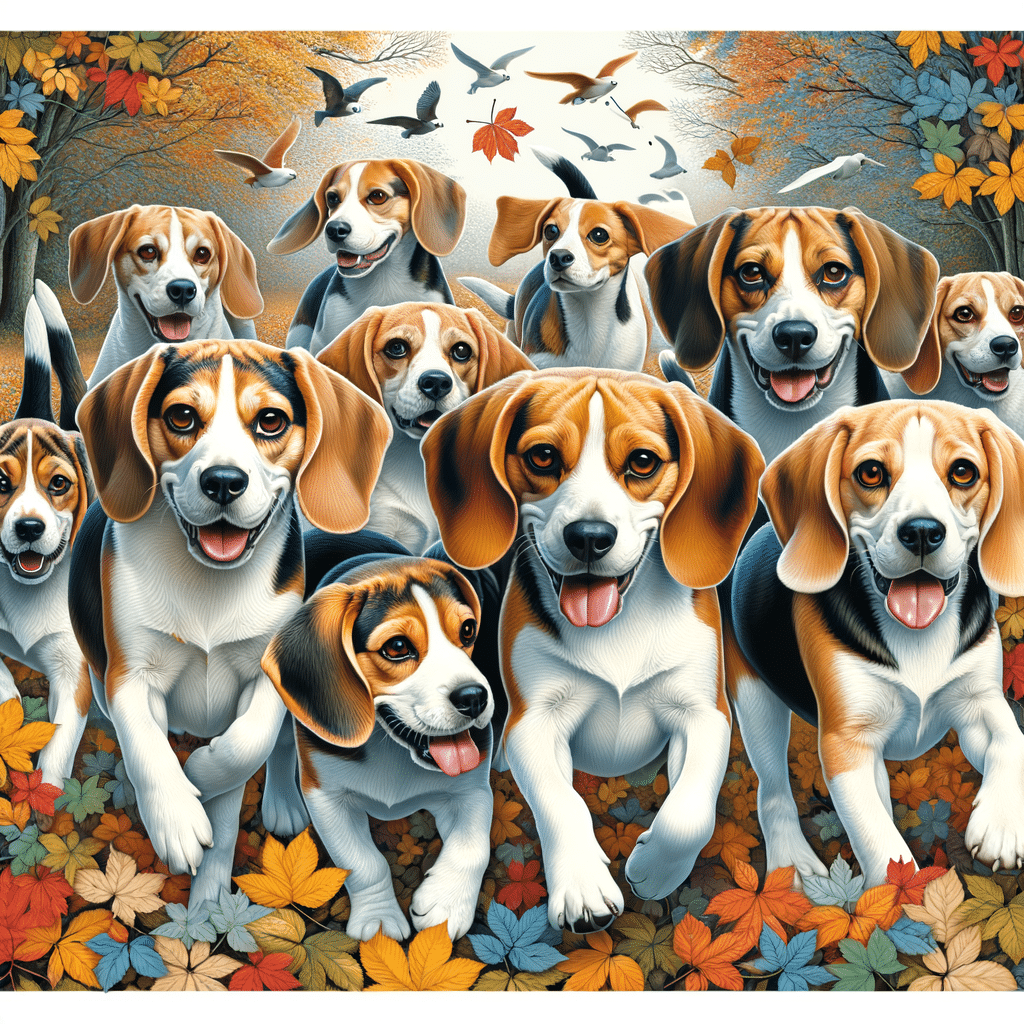Choosing the right dog breed can be challenging yet exciting for potential dog owners. The beagle and the Australian shepherd are popular breeds with qualities suitable for different lifestyles and preferences. Beagles are known for their compact size and joyful disposition, making them ideal companions for families and active individuals.
In This Article
Meanwhile, Australian shepherds are larger, highly intelligent, and energetic dogs that thrive when they can exert their herding instincts and enjoy various physical activities. Keep reading Beagle vs. Australian Shepherd: A Close Look to see which popular dog breeds might fit you.
Understanding these breeds’ distinctions is crucial to determining which may better fit your home and way of life. While both are great with children and have the potential to be wonderful pets for first-time dog owners, their care and lifestyle needs vary substantially.
Beagles require less grooming and are renowned for their keen sense of smell and tracking abilities, which require regular physical exercise to keep them happy. On the other hand, Australian shepherds have a lush double coat that necessitates more grooming, and they excel in dog sports due to their agility and intelligence.
Highlights
- Beagles and Australian shepherds suit various owners, but they differ in size, grooming needs, and activity levels.
- The beagle excels in tracking and requires regular physical exercise, whereas the Australian Shepherd is very agile and needs mental stimulation.
- Determining the right breed for a household depends on considering each breed’s unique characteristics and care requirements.
Breed Origins and History
Comparing the beagle with the Australian shepherd involves understanding both dogs’ evolution, from the beagle’s roots in England’s hunting traditions to the Australian Shepherd’s association with herding groups across continents.
Beagle Overview
Origin: England
Function: Hunting
The beagle’s history extends back to England, where it excelled in hunting. Used primarily for tracking hares, rabbits, and other small game, its keen sense of smell and stamina made it a valued companion for hunters. Originating in Roman times, the beagle we know today was further developed in the 1830s.
Australian Shepherd Overview
Origin: America (via Australia and Europe)
Function: Herding
Despite its name, the Australian shepherd, or “Aussie,” developed in the United States. Their story begins with Basque shepherds who, with their forebears, migrated from Europe to Australia and later to America with their Pyrenean shepherd and Collie-type dogs. Aussies found their niche as a working dog breed, adept at herding livestock. The breed was established and honed in America during the 19th and 20th centuries.
Physical Characteristics and Health
A dog breed’s physical composition and health are important factors for prospective owners. In comparing Beagles with Australian shepherds, key differences arise in size, appearance, and genetic health predispositions.
Comparative Size and Appearance
The beagle typically stands between 13-16 inches in height and weighs around 20-30 pounds. It is recognized for its compact size and muscular frame. Beagles have short, easy-to-groom coats and come in various colors, including tri-color, red and white, and lemon.
In contrast, the Australian shepherd is larger, generally ranging from 18-23 inches in height and weighing between 40-65 pounds. They have a medium-length coat that can be straight to wavy, and they often have distinctive coats with merle patterns, including blue merle. The Australian shepherd’s thick double coat requires more grooming.
Health Concerns and Lifespan
When assessing dog health, common concerns for beagles include hip dysplasia, epilepsy, and hypothyroidism. They are also at risk for patellar luxation and progressive retinal atrophy, which can affect their vision.
Australian shepherds face some similar health issues, such as hip dysplasia. They are additionally prone to hereditary eye problems like cataracts and a collie eye anomaly. Certain coat color patterns, particularly merle, can be associated with genetic defects affecting eyesight and hearing. Australian shepherds may also be affected by elbow dysplasia and osteochondrosis dissecans, a joint condition.
Both breeds can develop cancer, although it remains a general concern that’s not specific to the dog health of any one breed. The lifespans of beagles and Australian shepherds are comparable, with beagles living about 10-15 years and Australian shepherds 12-15 years on average, provided they receive appropriate care and health screenings. Both breeds need regular check-ups and attention to joint health to ensure a long and healthy life.
Temperament and Personality Traits
When comparing Australian shepherds and beagles, it’s essential to consider their personalities and temperaments, as these factors significantly affect their adaptability to different family environments and training approaches.
Behavioral Aspects
The Australian shepherd is known for being high-energy and intelligent. Originally bred as a working dog for herding, Australian shepherds have a strong work ethic and are often seen as agile and alert. They are loyal, quite loving, affectionate with their families, and protect those they are close to. Their energetic nature means they regularly require both mental and physical stimulation.
On the other hand, the beagle dog breed is friendly, curious, and merry. Although intelligent, they tend to be more independent in their actions. Beagles are also known for their loyalty, but they usually express their affection more outgoingly than the Australian shepherd. This breed’s origin as scent hounds influences their behavior, making them easily distracted by various smells.
Training and Socialization
Australian shepherd training must be consistent and mentally stimulating. Their intelligence and desire to please make them highly trainable. They excel in obedience and are often seen participating in dog sports. Socialization as a puppy is critical for Australian shepherds to manage their protective instincts and to ensure they remain well-adjusted pets.
Given their friendly personalities, beagles can be great family pets with appropriate training. However, due to their independent streak, they can be a bit more challenging to train. Consistent and patient training from the puppy stage is key for beagles, with a focus on positive reinforcement to make good use of their food-driven behavior. Socialization helps manage their tendency to follow their nose, potentially leading them astray.
Care and Lifestyle Needs
Choosing between an Australian shepherd and a beagle means understanding their distinct care and lifestyle requirements. Each breed has its unique grooming, exercise, and living environment needs.
Living Environments
Australian shepherds: Due to their high energy levels and intelligence, Australian shepherds thrive in environments where they can be active and engaged. They are medium-sized dogs that do best with a yard to play in. However, with enough exercise, they can adapt to apartment living. They are also equipped to handle cold weather because of their weather-resistant undercoat.
- Ideal for: Active families, houses with yards.
- Possible concerns: Apartments without adequate exercise, understimulation.
Beagles: Beagles are smaller and adaptable to various living situations, including apartments. They are known for their playfulness and enjoy both indoor and outdoor spaces. Their size and moderate exercise needs make them suitable for various homes.
- Ideal for: Most living situations, including apartments.
- Possible concerns: Lack of playtime, small spaces without regular walks.
Grooming and Maintenance
Australian Shepherds
- Grooming needs: This breed's coat requires regular brushing to manage shedding and avoid matting, especially during the shedding seasons.
- Shedding: Moderate to heavy, depending on the season.
- Health considerations: Regular veterinary check-ups to monitor common breed-specific issues like hip dysplasia and hereditary eye disorders.
Beagles
- Grooming needs: Beagles have a short, dense coat that is easier to maintain, requiring only occasional brushing to minimize shedding.
- Shedding: Moderate, requires less grooming effort than the Australian Shepherd.
- Health considerations: Prone to obesity if overfed, important to monitor their diet and ensure regular exercise.
Both popular dog breeds are intelligent and capable of learning routines, aiding in grooming and maintenance. They also need routine veterinary care, a balanced diet, and regular exercise to maintain their health and happiness. It’s important to note that Australian shepherds may require more mental stimulation due to their higher intelligence and energy levels.
Frequently Asked Questions
This section provides insights for potential dog owners into commonly asked questions about the distinctions and characteristics of beagles and Australian shepherds.
What are the differences in temperament between beagles and Australian shepherds?
Beagles are known for their friendly and curious nature, making them excellent family dogs. They can also be determined and single-minded, especially when tracking a scent. On the other hand, Australian shepherds are intelligent and energetic and often used as working dogs. They are loyal and may show protective traits, requiring mental stimulation alongside physical exercise.
How do the sizes of beagles compare to Australian shepherds?
Beagles are generally smaller than Australian shepherds, standing about 13-15 inches tall at the shoulder and weighing roughly 20-30 pounds. Australian shepherds are medium-sized dogs, usually standing 18-23 inches tall and weighing 40-65 pounds. Their larger size reflects their herding heritage.
What are the average health concerns for beagles and Australian shepherds?
Beagles typically live 10-15 years and may be prone to obesity, epilepsy, and spinal issues. Australian shepherds have a similar lifespan but can be susceptible to hip dysplasia, hereditary eye disorders, and collie eye anomaly, which they are screened for.
Which breed is more suitable for a family environment, beagles or Australian shepherds?
Both breeds are considered a good family dog. Beagles are often great with children due to their gentle and tolerant demeanor. Australian shepherds are also good family pets, especially in an active household, as they enjoy being involved in activities and can be great with older children.
What is the intelligence level of Australian shepherds compared to Beagles?
Australian Shepherds are considered to be highly intelligent and are ranked as one of the smartest breeds. They excel in obedience training. Beagles are also intelligent but are more driven by instinct and scents, which can sometimes distract them from training.
What are the exercise requirements for an Australian shepherd versus a beagle?
Australian shepherds require substantial daily exercise due to their high energy levels and working heritage. They thrive in active environments and enjoy tasks that challenge them both physically and mentally. Beagles, while also energetic and requiring regular exercise, often have less intense needs and benefit from activities like daily walks and play sessions to manage their weight and satisfy their curiosity.






